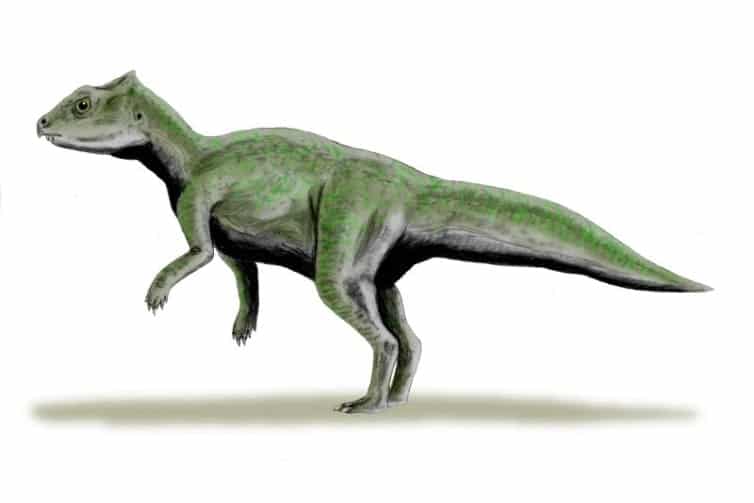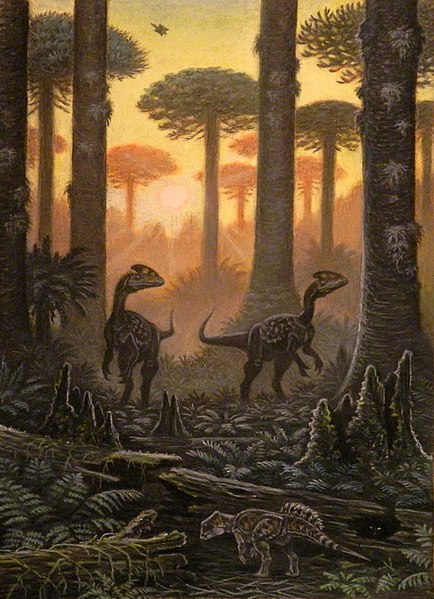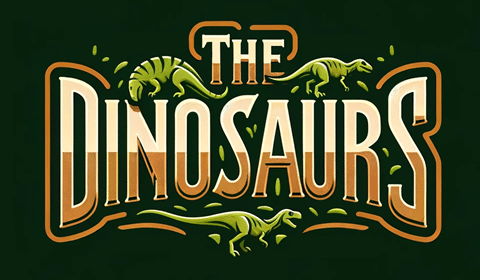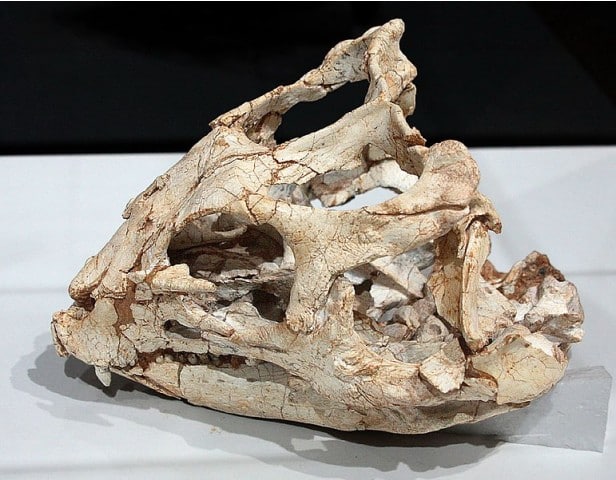Yinlong, whose name intriguingly translates to “Hidden Dragon” in Mandarin Chinese, lived during the Late Jurassic period. It was a small, agile ceratopsian herbivore that scurried around in what is today China. Yinlong is the oldest ceratopsian dinosaur ever found to date and as such it provides an interesting look at the evolution of later cerstopsians.
Yinlong holds an interesting place in dinosaur evolution despite its relatively small size. Its unique features and the time period it hails from make it a subject of great interest to paleontologists and dinosaur enthusiasts alike.
Yinlong Key Facts
| Keyword | Fact |
|---|---|
| Yinlong pronunciation | yin-long |
| Meaning of name | Hidden dragon |
| Group | Ceratopsia |
| Type Species | Yinlong downsi |
| Diet | Herbivore |
| When it Lived | 163.5 to 157.3 MYA |
| Period | Late Jurassic |
| Epoch | Oxfordian |
| Length | 3.9 ft |
| Height | 1.3 ft |
| Weight | 22 lbs. |
| Mobility | Primarily bipedal |
| First Discovery | 2004 by American and Chinese paleontologists |
| Location of first find | Xinjiang, China |
| First Described by | 2006 by Xu Xing, Catherine Forster, Jim Clark, and Mo Jinyou |
| Holotype | IVPP V14530 |
Yinlong Origins, Taxonomy, and Timeline

Yinlong gets its name from the Mandarin Chinese words ‘yǐn’ meaning hidden and ‘lóng’ meaning dragon. This name is not only a nod to the dinosaur’s elusive nature, but also a tribute to the rich cultural heritage of China, where its fossils were first discovered.
Belonging to the Ceratopsia group, it is part of the Chaoyangsauridae family. It is in fact the oldest ceratopsian dinosaur discovered, being a basal species providing some interesting insights into the evolution of the group.
Its type species is Yinlong downsi, named after American paleontologist William Randall Downs III. Mr Downs had participated in many paleontological expeditions to China before his death in 2002.
This dinosaur lived during the Late Jurassic period, specifically in the Oxfordian epoch, some 163.5 to 157.3 million years ago.
Discovery & Fossil Evidence
This species was first discovered in 2004 in Xinjiang, China by a team of American and Chinese paleontologists. This team included renowned paleontologists Xu Xing, Catherine Forster, Jim Clark, and Mo Jinyou. The discovery shed light on a previously unknown dinosaur species.
The first, and as far as I can find, the only specimen discovered was a nearly adult animal, complete with a well-preserved skeleton and skull. This discovery was made in the Middle-Late Jurassic strata of the Shishugou Formation, providing valuable insights into the dinosaur’s age and the environment it lived in.
When researching this dinosaur I have come across quite contradictory mentions of subsequent finds. Thomas Holtz, who is an often cited American paleontologist, states in a paper that there have been several finds of Yinlong fossils. However, this is not supported in any of the academic databases I have access to.
Regardless, the holotype specimen was quite complete and has provided a good understanding of the herbivore’s physical characteristics and lifestyle, making it one of the better-understood dinosaurs from the Late Jurassic period.
Yinlong Size and Description
Despite its formidable name, this was a relatively small dinosaur. Its size, however, did not diminish its significance in the grand scheme of dinosaur evolution.
Short description of Yinlong
Yinlong downsi was a small and primarily bipedal herbivore. Its body shape and physical characteristics were unique among ceratopsians–a group of dinosaurs known for their horned skulls and frilled necks. Yinlong, however, lacked the characteristic frill and horns associated with later ceratopsians. Its skull was deep and wide, relatively large compared to most ornithischians, but also proportionately smaller than most other ceratopsians. The dinosaur’s robust hindlimbs and slender forelimbs suggest a bipedal lifestyle, a trait it shared with many small ornithopods.
Size and Weight of Type Species
It was a relatively small dinosaur that reached only about 3.9 feet in length. It is estimated to have weighed around 22 lbs, making it one of the smaller members of the ceratopsian group. Despite its small size, Yinlong was a significant dinosaur that represents one of the earliest identifiable members of the ceratopsian group.
The Dinosaur in Detail

Yinlong was a dinosaur of considerable interest. Its unique features and the time period it hails from make it a subject of great interest to paleontologists and dinosaur enthusiasts alike.
The skull, for instance, was deep and wide–a feature that set it apart from most other ornithischians. Despite lacking the characteristic frill and horns associated with later ceratopsians, this skull was relatively large compared to most other ceratopsians. This unique skull structure provides valuable insights into the dinosaur’s eating habits and lifestyle.
The robust hindlimbs and slender forelimbs suggest a bipedal lifestyle. This trait is shared with many small ornithopods and indicates that Yinlong was likely a fast and agile dinosaur. Capable of quick movements to evade predators or chase after food.
The Yinlong in its Natural Habitat
This herbivorous dinosaur lived during the Oxfordian epoch of the Late Jurassic period during a time when the Earth was a vastly different place than it is today. The dinosaur’s fossils were discovered in the Shishugou Formation in Xinjiang, China, which provides valuable insights into the type of environment it inhabited.
The Shishugou Formation is known for its diverse fossil fauna, indicating that the environment was likely rich in biodiversity during this time. The climate was likely warm and humid with lush vegetation providing ample food for herbivores like Yinlong. The dinosaur’s herbivorous diet suggests that it fed on a variety of plants–possibly the ferns, cycads, and conifers that were common during the Jurassic period.
Its bipedal locomotion suggests that it was a fast and agile dinosaur that was capable of evading predators and navigating through dense vegetation. Its small size and agility likely allowed it to exploit food resources that larger, slower dinosaurs could not reach. The dinosaur’s robust hindlimbs and slender forelimbs suggest that it was well-adapted to its environment, capable of navigating through a variety of terrains with ease.
Interesting Points about Yinlong
- This dinosaur represents the earliest identifiable ceratopsian dinosaur, providing valuable insights into the evolution of this group of dinosaurs.
- Despite its small size and bipedal stance, the descendants of this dinosaur would evolve into the huge quadrupedal herbivores like Triceratops that lived at the end of the Cretaceous.
- It was named ‘Hidden Dragon’ in reference to the multi-award-winning film ‘Crouching Tiger, Hidden Dragon’, large portions of which were filmed in Xinjiang, where the dinosaur was discovered.
- The skull displays heterodontosaurid features. Heterodontosaurids are one of the most primitive groups of ornithischian dinosaurs.
- It was discovered with gastroliths preserved in the abdominal cavity, indicating that it used these stones to grind plant material. This practice carried down into successive generations and species.
Contemporary Dinosaurs
This Chinese dinosaur shared its world with a captivating group of contemporaries. Among these were the Asian dinosaurs Psittacosaurus, Shunosaurus, and Yangchuanosaurus. Each of these dinosaurs played their own unique role in the intricate rituals of survival and competition that characterized this era.
Psittacosaurus was a nimble creature that was even smaller in comparison to Yinlong. Its size possibly allowed it to navigate the terrain with a certain agility. This contrast in size might have led to an interesting dynamic between Yinlong and Psittacosaurus. Shunosaurus, on the other hand, was a larger creature. Its imposing presence could have posed a significant challenge to Yinlong, possibly leading to fierce competition for resources. Yet, it is equally possible that these dinosaurs maintained a delicate balance.
A possible predator for our dinosaur would have been Yangchuanosaurus. The large carnivore theropod might have been a frightening reminder of the dangers of this world for each of these herbivores. With their interactions governed by an unspoken understanding, a testament to the complex relationships likely arose in this prehistoric ecosystem. Through this lens, we can begin to appreciate Yinlong not just as an isolated species, but as a key player in a vibrant and dynamic prehistoric world.
List of All Dinosaurs
We have created a list of all dinosaurs we have covered here, sorted across the seven main groups of dinosaurs. We also include information about their type of diet, (omnivore, herbivore or carnivore) and the time they lived.
Frequently Asked Questions
It translates to ‘Hidden Dragon’ in Chinese, a nod to the dinosaur’s elusive nature and the rich cultural heritage of China, where its fossils were first discovered.
It belongs to the Ceratopsia group and is part of the Chaoyangsauridae family.
It lived during the Late Jurassic period, specifically the Oxfordian epoch, between 163.5 to 157.3 million years ago.
It was an herbivore that likely fed on a variety of plants that were common during the Jurassic period.
This species was first discovered in 2004 in Xinjiang, China,by a team of American and Chinese paleontologists.
It was a relatively small dinosaur, reaching only about 1.2 meters (3.9 feet) in length and weighing around 10 kg (0.01 ton).
Sources
- https://www.ncbi.nlm.nih.gov/pmc/articles/PMC1635516/
- https://royalsocietypublishing.org/doi/10.1098/rspb.2007.0367
- https://cdnsciencepub.com/doi/10.1139/E09-030
- https://www.researchgate.net/publication/260140027_Postcranial_Anatomy_of_Jeholosaurus_shangyuanensis_Dinosauria_Ornithischia_from_the_Lower_Cretaceous_Yixian_Formation_of_China
- https://www.jstor.org/stable/26787610
The information in this article is based on various sources, drawing on scientific research, fossil evidence, and expert analysis. The aim is to provide a comprehensive and accurate overview of Yinlong. However, please be aware that our understanding of dinosaurs and their world is constantly evolving as new discoveries are made.
Article last fact checked: Joey Arboleda, 01-10-2025

